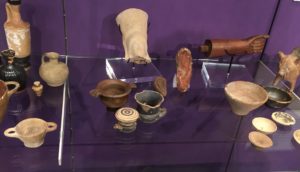What are votive offerings?
Votive offerings were an important religious practice in Ancient Greece that dated to as early as the 8th Century BC. The offerings were commonly left at sanctuaries and places of religious significance, and were dedicated to “express thanks to a deity or as payment in advance for anticipated help” (Renger 2016). The votives facilitated communication between the god and the individual and acted as a physical reminder of their piety. Votives came in many forms, from monuments to tiny clay figures, reflecting the wide array of cult practice in the different facets of Greek society. Miniature votive offerings, which include both small figures and vessels, are the basis of our investigation. These votives were hand moulded and likely to have been produced locally to the sanctuaries and available for worshipers to purchase. Our collection at the University of Birmingham consists of various miniature pottery vessels, and figures of both people and horses.
Where would they be found?
Votive offerings were most frequently left sanctuaries, “areas set aside for religious purposes and separate from the normal secular world” (Tomlinson 2020). Sanctuaries were usually made up of key components, an altar for sacrificial purposes, a temple to the god that also stored votive offerings (like the ones that we are investigating), and an open area for festivals and for worshipers to gather (Tomlinson 2106). Sanctuaries were used in various ways such as communicating with the gods through oracles and religious festivals. Many votive offerings would have been made locally to the sanctuaries, with the local economies being fueled by cult practices. Although we cannot be sure of the provenance of all of the votives in our collection, we do know that some of them came from the Perachora where there is a sanctuary of Hera.
How can they tell us about the people who deposited them?
Votive offerings are gifts to the divine deposited by worshippers, sometimes in hope that the favour will bring them good fortune, and other times as a sign of gratitude for what the gods have given them. But sometimes we are able to use these objects to see the people behind them through the location and contextual information surrounding their deposition.
There is evidence that potters would leave small pieces of their own work at these religious sites (Cook 1903: 266), some of which may include child produced crafts. Next week, we will be looking specifically at our corpus of miniature votive pottery within the CAHA Collection, with a specific focus on pottery that draws strong comparisons with Langdon’s methodological framework. These stand as examples of children (or child made votive objects) depositing gifts at places of religious significance.

Guided by Langdon’s methodology outlined in last week’s blog and the corpus of research collected throughout this project, the following two (final!) blogs of this series will focus on specific examples of votive objects from the CAHA Collection. Our collection in particular features misshapen miniature votive pottery, sculpted horses heads which have significant indications of child production, as well as the sculpture of human forms which are anatomically incorrect and compare to the likes of examples used by Langdon. These votive offerings vary in production quality, indicating variants of skill level and understanding of artistic competence. The quality of votive offerings within our collection represents the small scale production of religious objects as opposed to the large scale votives mentioned above.
Bibliography
Cook, A. B. 1903. ‘Greek Votive Offerings’, Folklore, Vol. 14, No. 3, 260-291.
Langdon, S. 2013. ‘Children as learners and producers in early Greece’ in Grubbs, J.E. and T. Parkin (eds.) The Oxford Handbook of Childhood and Education in the Classical World (Oxford).
Malkin, I. 2016 ‘Votive Offerings’ in S. Hornblower (ed.) Oxford Classical Dictionary. Oxford. (Accessed online 25 November 2020).
McC. H. 1920. ‘Greek Votive Offerings’, The Metropolitan Museum of Art Bulletin, Vol. 15, No. 2, 36-38.
Morgan. A. et al. 2016 ‘Delphi’ in S. Hornblower (ed.) Oxford Classical Dictionary. Oxford. (Accessed online 25 November 2020).
Renger, J. Frateantonio, C. ‘Votive offerings’ in Brill’s New Pauly, Antiquity volumes edited by: Hubert Cancik and , Helmuth Schneider, English Edition by: Christine F. Salazar, Classical Tradition volumes edited by: Manfred Landfester, English Edition by: Francis G. Gentry. Consulted online on 25 November 2020 .
Salmon, J. 2016. ‘Corinth, Greek and Hellenistic’ in S. Hornblower (ed.) Oxford Classical Dictionary. Oxford. (Accessed online 25 November 2020).
Tomlinson, R. A. ‘Sanctuaries, Greek’ in S. Hornblower (ed.) Oxford Classical Dictionary. Oxford. (Accessed online 25 November 2020).
